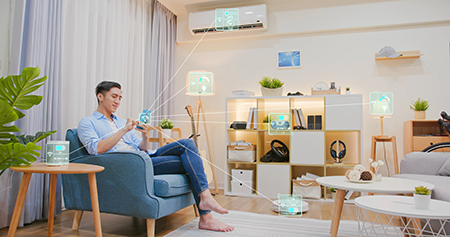The Rise of IoT
The Internet of Things (IoT) has emerged as one of the most critical technologies of our time,
SolutionDot holds the potential to revolutionize industries and modernize business processes. By connecting various devices via computer networks and sensors, IoT enables a seamless integration of the physical and digital worlds, driving value and performance across every sector, including government agencies, educational institutions, and private enterprises.
Long-Term Sustainability of IoT
The market value of
IoT is projected to soar from USD 478.36 billion in 2022 to USD 2,465.26 billion by 2029. However, the sustainability of this technology hinges on the adoption of robust measures. Despite its transformative potential, IoT adoption remains relatively low, primarily due to the high costs and complexity involved in implementation. Many organizations struggle with the significant operational changes required to integrate IoT solutions effectively.
Security Concerns in IoT
One of the foremost challenges in IoT is security. Many IoT devices are not adequately secured, making them susceptible to cyberattacks. Hackers can exploit vulnerabilities to access sensitive data or control devices, posing serious threats to both businesses and consumers. The difficulty in testing for vulnerabilities stems from the hard-wired integration of software and hardware, as well as the lack of a universal standard due to the diverse range of devices and manufacturers.
Privacy and Data Transparency
Transparency around data collection and usage is crucial. Device manufacturers must clearly disclose their privacy policies, enabling users to make informed decisions. Users should be aware of the data they share with companies like Google or Apple through apps and services. Addressing these privacy concerns is vital for building trust and promoting wider IoT adoption.
Environmental Impact of IoT
The environmental impact of IoT is another significant concern. The vast amount of data generated by
IoT devices contributes to climate change. With over 1 trillion new bytes of information created annually, the energy consumption required for data processing and storage is substantial. This trend is expected to continue, raising concerns about the long-term sustainability of IoT.
Leveraging IoT for Business Growth
Despite these challenges, the massive adoption of smart devices is set to fuel the growth of IoT. To maximize the benefits, IoT solutions must be user-friendly, flexible, and scalable. Businesses need to ensure that IoT systems are integrated seamlessly into their processes, providing meaningful insights and improving operational efficiency. Reducing procurement costs, utilizing low-cost sensors, and optimizing data processing can also drive wider adoption.
Data Protection and Ownership
Data generated by IoT devices is central to its success, but issues of
data protection and ownership remain significant barriers. Business leaders must address these concerns to ensure compliance with regulations such as GDPR and safeguard user privacy. Proper data management practices can unlock the full potential of IoT, enhancing productivity and business processes.
Overcoming IoT Adoption Challenges
The adoption of IoT is not without its challenges. The network of interconnected devices facilitates automation in various industries, from manufacturing to transportation. However, enterprises must navigate several pitfalls during the adoption process. Key challenges include high initial costs, integration complexities, and security vulnerabilities.

Conclusion
The future of IoT is undoubtedly promising, with the potential to transform industries and enhance business processes significantly. However, its success depends on overcoming challenges related to security, privacy, and sustainability. By adopting user-friendly, flexible, and scalable solutions, businesses can harness the power of IoT to drive innovation and growth. As IoT technology continues to evolve, addressing these critical issues will be paramount to realizing its full potential.
FAQ's
1. What is the Internet of Things (IoT)?
The Internet of Things (IoT) refers to a network of interconnected devices that can communicate with each other and with central systems over the internet. These devices, often embedded with sensors and software, collect and exchange data, enabling smarter decision-making and automation across various applications.
2. How does IoT work?
IoT works by connecting devices to the internet and to each other through sensors and communication protocols. These devices collect data from their environment or user interactions, which is then transmitted to a central system or cloud platform. The data is analyzed and used to make decisions, automate processes, or provide insights that can be acted upon in real time.
3. What are some common examples of IoT devices?
Common examples of IoT devices include:
- Smart home devices: Thermostats, lighting systems, and security cameras that can be controlled remotely.
- Wearables: Fitness trackers and smartwatches that monitor health metrics.
- Industrial sensors: Equipment that monitors and manages machinery and production processes in factories.
- Connected vehicles: Cars equipped with GPS, diagnostic tools, and autonomous driving features.
4. What are the key benefits of IoT?
Key benefits of IoT include:
- Enhanced efficiency: Automating routine tasks and optimizing processes.
- Improved data collection: Gathering real-time data for better decision-making.
- Cost savings: Reducing operational costs through improved management and predictive maintenance.
- Convenience: Providing seamless integration and control of devices and systems.
5. What are the main challenges associated with IoT?
Challenges associated with IoT include:
- Security: Protecting devices and data from cyber threats and unauthorized access.
- Privacy: Ensuring the secure handling of personal and sensitive information.
- Interoperability: Ensuring that devices from different manufacturers can work together seamlessly.
- Scalability: Managing and maintaining large networks of IoT devices as they grow.











 Saudi Arabia (English)
Saudi Arabia (English) United Kingdom
United Kingdom Global Site
Global Site